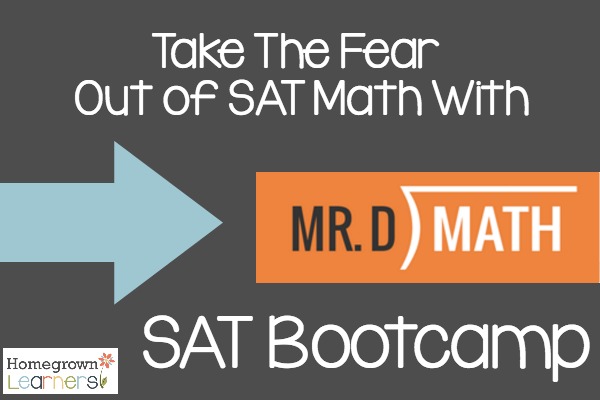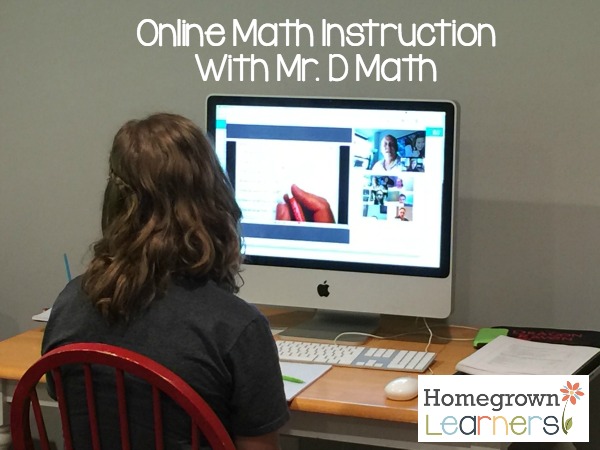Homeschooling big kids is tricky business.
The weight of having a child's entire high school education on your shoulders can be daunting and often times scary.
In recent months I have been researching what homeschoolers need to know about the SAT.
While I do preach "faith not fear", it does pay to be prepared when it comes to important things like transcripting, choosing courses, and standardized testing.
In these high school years, I am looking to experts to help me with some BIG decisions. My go to guy for all things SAT is Mr. D, or Mr. D Math. My oldest has taken Algebra Readiness, Algebra I and Geometry with Mr. D, and she is doing SO WELL!
I'm so happy Mr. D agreed to share with my readers about what homeschoolers need to know about the SAT.
With that - today I am turning the blog over to Mr. D!
As you can imagine, I am often asked many different things about homeschoolers taking the SAT.
What should a student expect to see on the SAT or PSAT?
When should a student take the SAT or PSAT?
What is the best way to prepare for the SAT or PSAT?
What are the PSAT and SAT?
The SAT stands for the Scholastic Aptitude Test. It was first administered in 1926 and was originally used to figure out who is awarded scholarships for Ivy League Schools. The SAT has become known as the test to take to “predict” how successful students would be in college.
The first PSAT Preliminary Scholastic Aptitude Test was administered in the fall of 1959. The test is a shortened form of the SAT and is designed to help students become familiar with the question types and format of the full exam.
What to expect on the SAT
Let’s look at the most current changes from the old version of the SAT to the new version of the SAT.
The SAT has been redesigned and the first “new” SAT was given in March 2015. The PSAT is now in effect as well.
Many people want to know how are the old and new tests differ.
While many things have changed, some things remain the same especially when it comes to math.
Here is a quick overview about the changes on the math portion so you can be prepared!
TIME:
Old: New:
3 tests 2 tests
20 questions 25 minutes 20 questions 25 minutes - No calculator
18 questions 25 minutes 38 questions 55 minutes - With calculator
16 questions 20 minutes
CONTENT:
Old: New:
Algebra I, Geometry, some Algebra II Algebra I, Geometry, Algebra II Trigonometry, Data Analysis (Probability and Statistics)
There will be free response and multiple choice questions on the new SAT as there were on the old SAT.
The style of the questions are similar from the old test to the new test but the new test requires a higher level of math skills.
Higher Level of Math Skills Required on the New SAT
For the new SAT, students will need to have a broader range of math skills through Algebra II and into a Pre-Calculus class that has Trigonometry. Students will also need to recognize and work with function notation. Finally, students will need a solid grasp of workingwith probability.
The best way for students to prepare is to practice and get familiar with the kinds of questionsthat will be asked on the new SAT.
The scoring will be similar out of 800 possible points except now there will NO LONGER be points subtracted for wrong answers.
When should students take the PSAT?
Students usually take the PSAT during the 10th grade year in October and then take the SAT the following year as junior. Students can take the PSAT as a th grader if they are ready.
What do I mean by being ready?
That would be students who have completed Algebra I, Geometry and are at least ½ way through their Algebra II curriculum.
In the past if students had completed Algebra I and Geometry they were ready for a first time attempt at the SAT or PSAT. Now, with the new broadened amount material, it is wise to wait.
Students who attempt the new SAT format without having completed Algebra II feel like they were seeing things they had never seen before. They are correct as they just haven’t seen it yet without completing Algebra II first.
Math Topics to Be Familiar with on the SAT
Slope of a line and what does it mean. (I will share more about this later in this article.)
Y intercepts.
X Intercepts which on the SAT are called zeros or real solutions to a quadratic equations.
Systems.
Sine, Cosine and Tangent relationships
Alternate interior angles, corresponding angles, same side interior angles, transversals
creating parallel lines.
Proportions.
Compound interest
Indirect and direct variations.
The Pythagorean Theorem.
Triangle relationships.
Matrices.
Probability.
Relationships between the Mean, Median and Mode.
Equation of a circle and identifying the center.
Equation of a parabola in standard and vertex form.
Identifying the vertex or zero of a parabola.
There are more of course, but as you cans see, this is a much broader list than the older version of the SAT.
What is the best way to prepare for the SAT or PSAT?
First, let’s start with the best ways NOT to prepare:
1. Do not take the SAT or PSAT to get a baseline of where a student is.
(I know this is a tough one for some moms!)
Students who have never seen the format of the test are now dealing with not only the content, but the style of the question and the time limit constraints. The baseline you will have is not a true assessment of where the student really is. There are likely questions they could have answered if they understood the style and formatting of the question.
Translation - They knew the material but did not know what they were being asked.
2. Do a question or two a day for several months before the SAT test date as the only preparation. The SAT comes at you in a timed fast pace setting. While the “question a day” is a great tool, don’t let it be the sole source.
3. Practice 50 problems of slope then 50 problems of alternate interior angles formed by parallel lines, etc. The SAT doesn’t deliver the content in this format, so saturating yourself with drill and practice on these topics usually doesn't produce the intended result.
Let’s look at the best ways to prepare:
1. Learn the language of math.
Here are some examples!!!!
a. Slope - when a question on the SAT or PSAT is asking about the slope of a line, it will likely not say “what is the slope of the line?” Instead, it will ask what is the rate of change or how many hours per month or for each inch. The word “rate of change”, “per an interval” or “for each unit” refer to slope. Slope is a rate of change looking at how one variable is changing in relation to the other.
b. Y- Intercept – The y-intercept students will say happens when a graph crosses the y axis. What they sometimes miss is that the y-intercept occurs when the x value of the graph is 0. The x axis usually refers to time which means what is happening when something begins. The SAT will when asking about a y-intercept will use words like “start, begin or initial.”
2. Take practice tests.
The SAT publisher, https://www.collegeboard.org/ has prepared some great practice tests that are available on their website.
3. Use a timer with the practice tests and take the test the way it will be given.
Once a student has seen what they know, how the test is structure and what to expect,
preparing becomes a game plan as opposed to a guess. What I see over and over again with students these days is young people are just as busy as their parents.
Students tell me often, "I have to make time to study for the SAT."
Something I have noticed about the word "study" is that it is a little like going to the dentist. We should but if we can put it off, we will.
Something I have noticed about the word "study" is that it is a little like going to the dentist. We should but if we can put it off, we will.
For me, studying for the SAT is something that doesn't really work anyway. While there are plenty of 700 page "study" guides for the SAT, what students really need to is practice. Just like an athlete, artist or musician, the way to become great at something is to practice.
When I ask students when they are going to practice for the SAT, they are not as opposed to picking a time and then doing just that, practicing for the SAT. Knowing how long to practice and what to practice makes all the difference.
Having a scheduled time each week or even a few times a week as the test date draws near is the best approach. Just like dance class practice or soccer practice, the practice is scheduled and you know you will be going.
SAT Prep With Mr. D
The live 6-Week Online Math SAT Bootcamp gives you immediate access to the Mr. D Math Test Prep Portal with over 6 hours of video training for the SAT math sections, plus online practice tests and additional resources for the SAT, ACT, and PERT tests in all subject areas.
In this interactive program, we will cover everything your student needs for success on the math portion of the SAT.
In addition to test-taking "secrets" and strategies mentioned above, we'll review all the formulas they'll need to memorize. Students will take multiple practice tests so they can see the results of what they've learned in action.
Dennis DiNoia has been immersed in education for over 25 years. He holds a M.A. in Education from the University of South Florida and has been a Florida State Certified Secondary Mathematics Teacher since 1988.
10 years ago, Mr. D left the public school system to develop an online curriculum for all levels of high-school math, from pre-algebra to pre-calculus. His unique and effective approach teaches students to understand math as a language, and he infuses problem-solving skills that transfer to everyday life.
Mr. D has had great success in assisting students to raise their test scores on SAT/ACT/FCAT and other standardized tests. Due to the need for assistance in this area, he created specialized test preparation seminars and online videos based upon his years of experience in the school system and private tutoring industry.
Thank you, Dennis, for equipping and empowering high school parents everywhere!
I can rest easy knowing we have a plan for SAT prep for Anna over the next couple of years.









